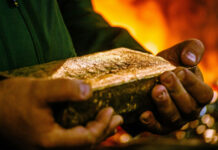
[miningmx.com] — GIVEN his previous scepticism concerning the subject, it’s not surprising that Harmony CEO Bernard Swanepoel’s apostasy on uranium captured the headlines after the firm’s March quarterly presentation.
After all, as he said, something that might have been worth 100c/share becomes a lot more interesting if it may turn out to be worth 1000c/share, though he stressed that Harmony doesn’t want to be “another failed gold mine saved by discovering uranium”.
That remark predictably raised a few chuckles, though Swanepoel hastened to add that he didn’t have anybody in particular in mind in which case you have to wonder just how the thought came into his head.
Of course, that 1000c/share is also a hypothetical – not to say thumbsuck – figure and we’re promised more specifics, possibly even a resource declaration, at the June quarterly presentation.
Randfontein’s Cooke section and some of the Free State properties seem the most prospective. It’s good to see Harmony waking up to uranium, even if Swanepoel concedes that maybe it should have started three years ago.
However, analysts at the briefing seemed more concerned with the sale of the Orkney properties to Pamodzi Gold. To some, Orkney seems to be just the sort of property on which the original Harmony concept was based.
Swanepoel’s riposte was that the current Harmony portfolio is very different from what it was 10 years ago. In any consideration of how Harmony should allocate available capital, Orkney would come way down the list. But Pamodzi, said Swanepoel, has different priorities and would find Orkney a “shining new toy”.
Orkney earned a cash operating profit of R54m in the March quarter, said Swanepoel. He agreed that it could have been floated separately, but reckons the Pamodzi deal was the most value-creative while the royalty element of 3% on the first 1 million oz produced and 1.75% thereafter retains leverage to the gold price for Harmony, on top of the immediate receipt of R350m cash and R200m in Pamodzi Gold shares.
But he also stressed that Harmony remains bullish concerning the gold price. It has no general policy of trying to sell so-called leverage (or marginal) mines, but there may be other minor properties it could pass on.
Swanepoel cited Kalgold, which has only two to three years’ life left, which it won’t pay Harmony to try to extend, as another possible candidate for sale.
The fact is, this all shows that Harmony is losing the characteristics that were its original value proposition. It has matured and is now much more like a typical old-style multi-property gold miner that has some substantial conventional developments on hand. The differences between Harmony and, say, AngloGold Ashanti are becoming blurred.
That doesn’t mean that Harmony is going ex-growth. It plans to spend up to R3bn on capex this year in South Africa and Papua-New Guinea, which may then tail off unless uranium projects require big spending. But it makes the company less exciting (if not, I’m sure, to Swanepoel) and may affect the criteria the market applies to rate the share.
Another aspect of the greying of Harmony is its decision to drop live briefings of its March and September quarterlies and restrict those to interim and year-end results. Swanepoel calls that “in line with industry practice”.
Indeed it is, but he above all – who used to boast of the Harmony way, a phrase we seldom hear now – should know that industry practice and best practice aren’t the same thing. It’s a pity to trade down from the one to the other, and the attendance and keen questioning at what it seems will have been the last-ever March quarterly briefing show just how valuable analysts and investors find such occasions.
However, no doubt it’ll make for a useful saving in the company’s catering and entertainment expenses.











